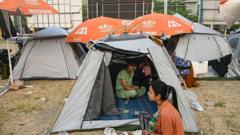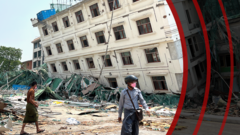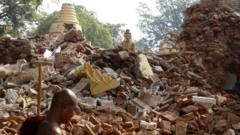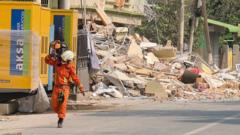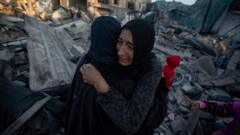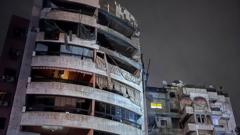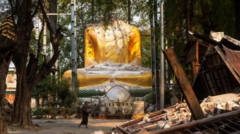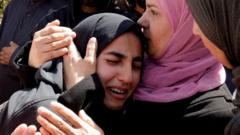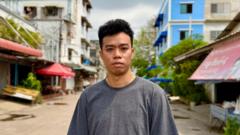Mandalay is grappling with immense loss after a massive earthquake left over 2,700 dead and thousands more affected. As residents cope with dwindling supplies and trauma, they face challenges in relief efforts complicated by civil conflict and military restrictions.
Mandalay's Tragedy: The Aftermath of a Devastating Earthquake
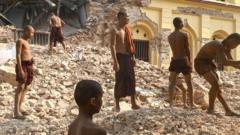
Mandalay's Tragedy: The Aftermath of a Devastating Earthquake
The city once celebrated for its pagodas now faces a grim reality following a catastrophic earthquake, revealing the struggles of survivors amid escalating death tolls.
Article text:
Once known as the 'city of gold' adorned with shimmering pagodas, Mandalay now stands as a stark reminder of loss and despair following a devastating earthquake that struck the region last Friday. The 7.7 magnitude quake, which also impacted neighboring Thailand and China, has resulted in a horrifying accumulation of corpses, leading locals to report they have had to “cremate in stacks.”
The aftermath has seen the death toll soar to more than 2,700, with 4,521 injured and countless individuals still unaccounted for. As misinformation surrounding the casualties spreads, fears mount that official numbers may only scratch the surface. Survivors have expressed their anguish, with one resident echoing the pain of family loss as her aunt’s body was unearthed two days later.
Poor infrastructure combined with ongoing civil turmoil has severely hindered relief efforts across Myanmar, a country already battered by severe challenges since the military seized power in 2021. Many families now reside in makeshift shelters or have taken to living on the streets, fearing the structural integrity of their homes amidst persistent aftershocks.
Despite the overwhelming sense of hopelessness, rescue operations have made some strides. Reports indicate that emergency teams have rescued over 400 individuals but locals believe the true scope of the disaster remains unacknowledged. Conditions have only worsened with critical resources like food, water, and essential supplies running low.
Amid this turmoil, children are particularly affected, exhibiting signs of trauma borne from witnessing destruction. One local pastor recounted the emotional impact the disaster has had on his son, who has frequently broken into tears since the quake.
While the authorities called for a day of mourning and sought to show respect for the victims by lowering flags, stories highlight a dire reality where even the basic equipment for managing the deceased is insufficient.
International support has trickled in, with nations such as China and Russia offering assistance to Myanmar's military government, yet roadblocks imposed by military forces raise concerns over the speed and effectiveness of rescue missions. Many humanitarian organizations have reported stringent restrictions which complicate their mission to provide vital aid to affected areas.
As grassroots movements and resistance groups announce temporary ceasefires to facilitate relief, the military's continued aggression amidst such suffering draws condemnation. Analysts urge the junta to change their approach and prioritize aiding the communities affected by the earthquake, reinforcing the dire need for openness amidst the urgent humanitarian crisis.
Once known as the 'city of gold' adorned with shimmering pagodas, Mandalay now stands as a stark reminder of loss and despair following a devastating earthquake that struck the region last Friday. The 7.7 magnitude quake, which also impacted neighboring Thailand and China, has resulted in a horrifying accumulation of corpses, leading locals to report they have had to “cremate in stacks.”
The aftermath has seen the death toll soar to more than 2,700, with 4,521 injured and countless individuals still unaccounted for. As misinformation surrounding the casualties spreads, fears mount that official numbers may only scratch the surface. Survivors have expressed their anguish, with one resident echoing the pain of family loss as her aunt’s body was unearthed two days later.
Poor infrastructure combined with ongoing civil turmoil has severely hindered relief efforts across Myanmar, a country already battered by severe challenges since the military seized power in 2021. Many families now reside in makeshift shelters or have taken to living on the streets, fearing the structural integrity of their homes amidst persistent aftershocks.
Despite the overwhelming sense of hopelessness, rescue operations have made some strides. Reports indicate that emergency teams have rescued over 400 individuals but locals believe the true scope of the disaster remains unacknowledged. Conditions have only worsened with critical resources like food, water, and essential supplies running low.
Amid this turmoil, children are particularly affected, exhibiting signs of trauma borne from witnessing destruction. One local pastor recounted the emotional impact the disaster has had on his son, who has frequently broken into tears since the quake.
While the authorities called for a day of mourning and sought to show respect for the victims by lowering flags, stories highlight a dire reality where even the basic equipment for managing the deceased is insufficient.
International support has trickled in, with nations such as China and Russia offering assistance to Myanmar's military government, yet roadblocks imposed by military forces raise concerns over the speed and effectiveness of rescue missions. Many humanitarian organizations have reported stringent restrictions which complicate their mission to provide vital aid to affected areas.
As grassroots movements and resistance groups announce temporary ceasefires to facilitate relief, the military's continued aggression amidst such suffering draws condemnation. Analysts urge the junta to change their approach and prioritize aiding the communities affected by the earthquake, reinforcing the dire need for openness amidst the urgent humanitarian crisis.

